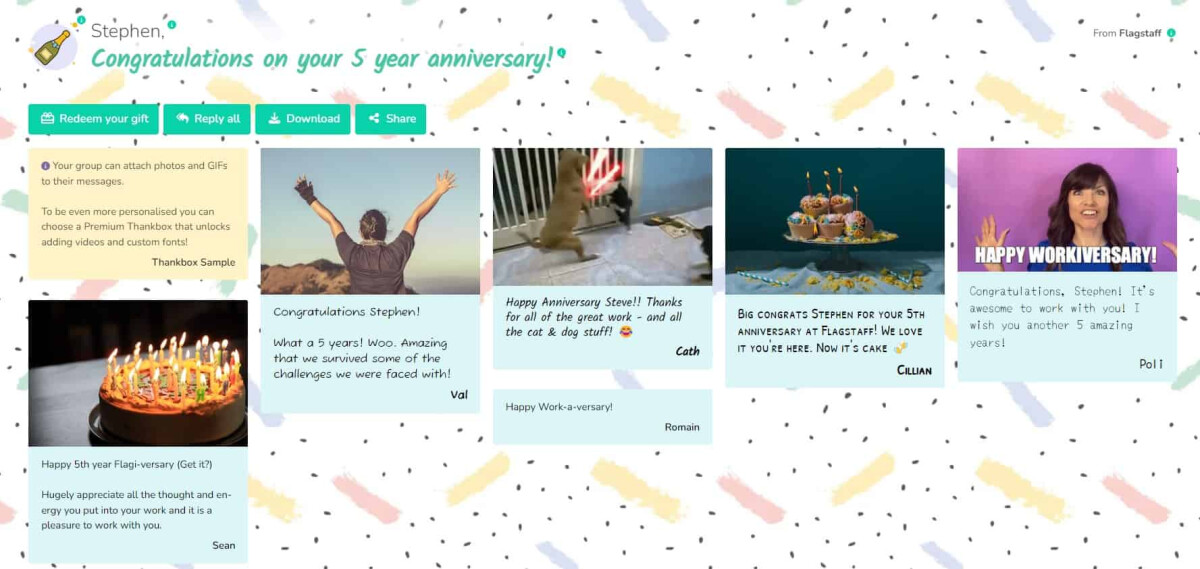Top 15 Tips for Delivering Constructive Feedback at Work


Ah, feedback at work. It’s like watching Tom Cruise perform Mission Impossible stunts – exhilarating but slightly terrifying. But let’s face it, whether you’re delivering or receiving feedback, it’s as essential as your morning coffee.
Done right, it can propel careers and productivity. Done wrong? Let’s just say it can be like accidentally hitting “reply all” with a meme meant for your work buddy.
So, how do you provide constructive feedback that propels success? It’s not just about what you say – it’s about how, when, and where you say it. And no, unfortunately, the answer isn’t “whisper it softly while they’re wearing headphones.”
Fear not! Here at Thankbox, we’ve compiled 15 fantastic tips for delivering constructive feedback at work. All real, practical, and fun! Let’s dive in!
What is constructive feedback?
In the simplest terms, constructive feedback is like a GPS for your career path. It’s not just about pointing out what went wrong – it’s about offering clear, actionable advice for improvement. Think of it as a “helping hand” rather than a “slap on the wrist.”
This kind of feedback is a two-way street. You’re there to support and guide, not just critique. It's an assessment that leaves the recipient feeling clear on how to grow rather than deflated and confused.
Distinct from positive feedback, which centres on praise and recognition, constructive feedback delves deeper. It combines appreciation with specific, actionable advice, steering towards individual development.
Delivering constructive feedback at work
Now that we’ve covered the basics – let’s dive into 15 tips for giving constructive feedback to your employees:
1. Prioritise face-to-face chats
Direct, face-to-face workplace communication demonstrates respect, promotes open dialogue, and prevents misunderstandings. Such interactions maintain morale and ensure that criticism is received constructively.

Speaking of maintaining morale, Thankbox is an ideal tool for boosting it, especially when celebrating team milestones like work anniversaries and birthdays. After face-to-face feedback sessions, use Thankbox to send a group e-card filled with supportive messages, GIFs, and videos.
This gesture amplifies team spirit and appreciation and is a tangible reminder of group support and encouragement.
2. It’s not what you say but how you say it
Your tone and delivery can either open ears or slam doors. A supportive, positive tone turns feedback into a tool for progress, whereas a harsh tone might lead to resistance or worse – demotivation. So choose your words and tone wisely.
3. The sandwich method (not just for lunch)
The sandwich method is a classic positive-negative-positive feedback approach. The bread (positive feedback) is pleasant. The filling (constructive criticism) is where the real substance lies, but it needs to be balanced by the bread. Start with something positive, insert your constructive critique in the middle, and then top it off with more positivity.
4. Be specific

When giving feedback, specificity is your best friend. It’s about providing clear, actionable advice, not overanalyzing every minor detail. This approach helps employees understand exactly what they need to do to improve, perfect for elevating your team to excellence.
5. Keep it constructive, not destructive
Constructive feedback encourages growth, unlike destructive feedback which hinders progress. Instead of criticising with comments like, “This report is terrible,” opt for a more nurturing approach such as “The report has strong points, but let’s work on enhancing your arguments.”
6. The two-way street of feedback
Feedback should be a dialogue, not a monologue. Think of it as a traffic system where both ways should be clear for communication. Motivate employees to share their thoughts and perspectives by asking about their thought processes while performing certain tasks. This approach provides you with insights to improve your leadership style.
Ready to transform your team’s dynamics? Start giving effective, constructive feedback today. Boost communication, support growth, and foster a positive work environment with a Thankbox.
7. Clarify the “why” behind your feedback
When giving constructive feedback, remember to explain the reasons behind it. Usually, it’s because you see potential for development. By offering a clear explanation, you help them understand the context and purpose of your feedback, making them much more receptive.
8. Embrace active listening

Active listening goes hand-in-hand with constructive feedback. Engage deeply by maintaining eye contact, asking clarifying questions, and using empathetic verbal and non-verbal cues. This builds trust, making employees feel heard and valued.
9. Timing is everything
The timing of your feedback can be as impactful as the feedback itself. Highlighting mistakes publicly can cause embarrassment and hinder motivation. Opt for a private discussion at a suitable time. It’s also vital to address problems swiftly to prevent them from escalating.
10. Set the stage for feedback
At the beginning of any feedback session, inform the employee that you’ll be offering constructive feedback. Giving even short notice allows the employees to mentally brace themselves and approach the feedback with a receptive mindset.
11. Stay objective
When giving feedback, separate the person from their actions. Approach discussions with an open mind, aiming to uncover underlying reasons for actions, which often stem from simple misunderstandings. Always keep the conversation respectful.
12. No one-size-fits-all

Remember, feedback isn’t one-size-fits-all – tailor it to the individual. What works for one person might not for another. Take the time to understand each employee’s unique style and needs. This personalised approach keeps your feedback relevant.
Ready to transform your team’s dynamics? Start giving effective, constructive feedback today. Boost communication, support growth, and foster a positive work environment with a Thankbox.
13. Follow up
After delivering feedback, don’t just disappear. Touch base with the receiver to discuss progress and any support they might need. This ongoing engagement demonstrates your commitment to their development and avoids them being left in the dark.
14. Allow time for questions
After sharing your feedback, offer an opportunity for any clarifying questions they might want to ask. Create a space where they feel comfortable in follow-up discussions. This is a great step towards developing strong professional bonds.
15. Practise makes perfect

And last but not least, providing effective feedback gets better with practice. Don’t expect to hit all the right notes from day one. It’s a skill that improves over time with experience and reflection. Be open to learning and evolving your approach.
Final thoughts
Delivering constructive feedback doesn’t have to feel like a high-wire act. With these 15 tips, you can give feedback that addresses improvement while still building up your team’s morale.
Remember, it’s about creating a workplace where employees feel motivated to grow.
And for those special moments of recognition, don’t forget tools like Thankbox that amplify positive vibes. Create a Thankbox today and transform feedback from a chore into an opportunity.
Images: Cover | Two women having a conversation | Woman in an online meeting | People giving each other feedback | Smiling man leaning on a blue wall





